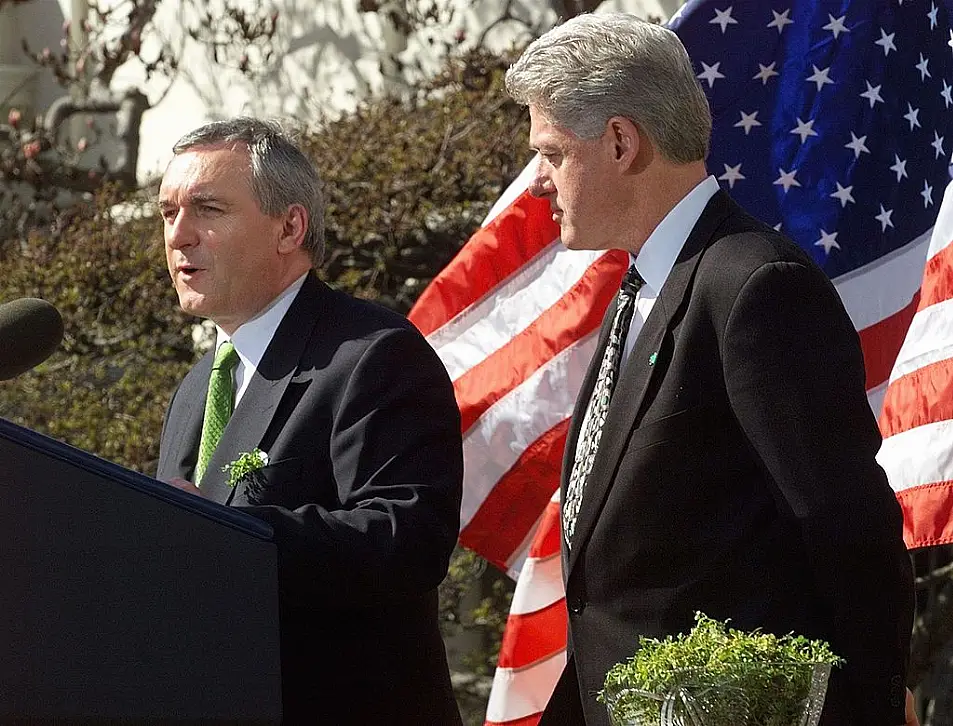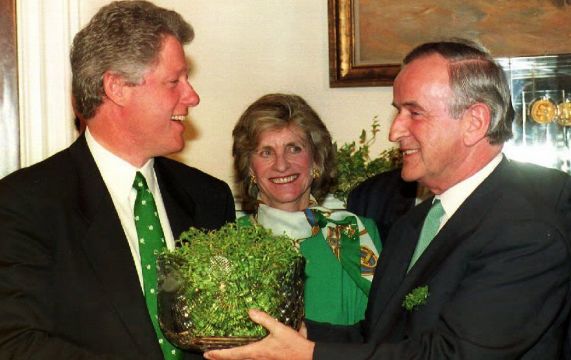Taoiseach Leo Varadkar will meet US president Joe Biden for the official St Patrick's Day shamrock ceremony in Washington DC on Sunday.
This year's St Patrick Day meetings were split, so Mr Varadkar met Mr Biden for bilateral meetings at the White House on Friday, while the traditional US House speaker's lunch took place at the US Capitol.
He will meet the president again on Sunday for the shamrock ceremony.
So where did the traditions start?
Dr Brian Murphy is a lecturer in Communications and Modern Irish History at TU Dublin
He spoke to BreakingNews.ie about the tradition of Irish White House visits for St Patrick's Day, and how they started.
He explained that you have to look back to the end of World War Two for the visit's origins. Éamon de Valera infamously offered condolences to Germany after the death of Adolf Hitler, and Dr Murphy said "the way that was portrayed in American newspapers didn't do a lot for Ireland's popularity in the US".
Relations were already strained as the US had taken a dim view of Ireland's policy of neutrality during World War Two.
"After the war, the attitude in the US State Department was to treat Ireland with a cool breeze. That was the case until the early 1950s."
Seán T O'Kelly was elected president of Ireland in 1945, just after the end of World War Two, and he was determined to improve Irish-American relations.
Dr Murphy, who is currently writing a book about O'Kelly, explained that his desire to secure an official invitation to the US is where the origins of the shamrock ceremony can be traced back to.
"During his first term, a number of approaches were made for the US to invite president O'Kelly for an official visit. None of those attempts were successful. The cool breeze was still there.
"In 1952, John Hearne was the Irish ambassador to the US. Hearne and O'Kelly cooked up a scheme where on St Patrick's Day 1952, in an attempt to thaw the US-Ireland relationship, Hearne arrived at the White House on St Patrick's Day 1952 with a bowl of Shamrocks that said 'happy St Patrick's Day with compliments of the president of Ireland'.
"When Hearne arrived, president Harry Truman was actually on holiday in Keywest in Florida. Truman eventually saw them and replied with a telegram to president O'Kelly wishing him well, thanking him for the shamrocks, and speaking about good relations between Ireland and the United States.
"O'Kelly saw that as a boost to his efforts for an invitation. Every year after that, the Irish ambassador would arrive to the White House with a bowl of shamrocks."

In 1956, John A Costello became the first taoiseach to deliver the shamrocks personally to a US president, Dwight Eisenhower.
"It then reverted to the ambassadors and O'Kelly was running out of time as his second term was to end in 1959.
"Eventually, the efforts paid off, and he was invited to the United States and arrived in March 1959, the day before St Patrick's Day. O'Kelly had a great eye for publicity and there's a great photograph after he got off the plane in Washington. Eisenhower was there to greet him and O'Kelly walked down the plane steps, greeted Eisenhower, and pinned the shamrocks on to Eisenhower's lapel.
"O'Kelly addressed the US Congress the following day."
Dr Murphy, who is a director of the Kennedy Summer School, said Irish ambassador Tom Kiernan played an important role in St Patrick's Day ceremonies during John F Kennedy's presidency.
The visit was now an official scheduled one, and Kiernan sought to play up to JFK's interest in Ireland with "pieces of Irish genealogy along with the traditional shamrocks".
"One year he gave Kennedy a treaty that had been signed by the O'Kennedy tribe in medieval Ireland.
"He was trying to encourage Kennedy's interest in Ireland and this, on behalf of the Sean Lemass government, paved the way for JFK's visit in 1963. That was despite his own advisers telling him he had all the Irish-American votes already, and that he would be left open to accusations of a pleasure trip.
"The shamrock ceremony continued after Kennedy with Lyndon B Johnson, who was conscious of Kennedy's legacy in keeping the shamrock ceremony going, although possibly without the same enthusiasm."

Dr Murphy said Richard Nixon added his own stamp to the St Patrick's Day visit, using it to make policy announcements.
"One year Nixon announced his new ambassador to Ireland, and another to tell the US press he was visiting Ireland in 1970. That visit wasn't well-received and there were protests because of the Vietnam War."
The ceremonies were all carried out by ambassadors, with the exceptions of O'Kelly and Costello, until the 1980s when it became an annual event where the taoiseach visits Washington DC.
"Garret FitzGerald was the first to start visiting every year between 1982 and 1987.
"He was trying to influence Ronald Reagan to get involved with Northern Ireland. Reagan did take some interest in Northern Ireland. The difficulty was he saw the special relationship between the US and UK as more important, and he had a strong bond with Margaret Thatcher."
The US House speaker's lunch was then added to the St Patrick's Day schedule.
While there are often criticisms of the taoisigh's visits, and calls for boycotts, Dr Murphy feels the access given to Ireland is "extraordinary".
"What's extraordinary is the speaker's lunch and White House shamrock ceremony, the access for a small country like Ireland. It's almost a cliché, but countries 100 times our size would give their right arm diplomatically for that access.
"We have a standing date in the US president's calendar every year. No other country has that.
"The US president has two scheduled visits to the Capitol every year, the State of the Union address and the speaker's lunch on St Patrick's Day for the taoiseach."
He said FitzGerald and then Charlie Haughey sought to use that access to highlight peace initiatives for Northern Ireland, the undocumented Irish in the US, and Irish-American economic and trade links.
"Reagan once joked that St Patrick died in 461, and you could only rely on the Irish to keep that wake going for another 1,500 years. You're kind of going 'OK, this is all shamrocks and shillelaghs' but beyond that, and sometimes in politics there has to be something for everyone, presidents signalling their Irish roots, but it also allows our government access to the highest level of global politics and to raise issues of concern for Ireland."
Dr Murphy said the St Patrick's Day visit "really took off" after Bill Clinton was elected president in 1993.
"St Patrick's Day really took off in the Bill Clinton era with his interest in the peace process. Clinton understood the power of soft diplomacy. Albert Reynolds, John Bruton, and Bertie Ahern during the Clinton era saw the ceremony become a much bigger and more open event.

"Clinton was extending the invite beyond the taoiseach's entourage to all of the players in the Northern Ireland peace process. Big banquets in the White House took place, people from all over Ireland and Northern Ireland were invited and Clinton's key message in the addresses were 'you must get it done, you must make the leap for peace'."
Under George W Bush, he said this was "scaled back a bit", but "still much bigger than the pre-Cinton era".
"Barack Obama kept it going, he got a lot out of the discovery of his Irish roots. He turned the White House fountain green, mirroring the river in his home city of Chicago.
"Brian Cowen was there in 2009 and 2010 when the economic recession was kicking in. Obama then visited Ireland, by which stage Enda Kenny is taoiseach."
The election of Donald Trump led to calls for Kenny to boycott the visit.

"Kenny was under a bit of pressure when Donald Trump was elected. There was a school of thought that given some of the things Trump had said during his election campaign, on his first St Patrick's Day, the taoiseach shouldn't go.
"Kenny decided, as did Leo Varadkar his successor, that this is incredible access for Ireland. No matter who the White House incumbent is, we should be there. There was also the risk of losing the slot for good.
"Taoisigh have also had the chance to appraise Trump and his successor Joe Biden about things we may not be comfortable with, in terms of the Irish-American relationship."
Dr Murphy added: "Micheál Martin was particularly unfortunate as he was named taoiseach at the height of the pandemic. The Government was determined to keep up the tradition, so a virtual shamrock ceremony took place in 2020, and in 2021 he tested positive for Covid while in Washington, so he had to take part in a virtual ceremony again."
I think it would be a major diplomatic own goal to let it go.
There had been calls for Leo Varadkar to boycott the visit over US support of Israel as the bombardment of Gaza continues. However, Dr Murphy argued that it was better to keep the tradition going and raise these issues with Mr Biden in person.
"This St Patrick's Day there has been some noises that the Taoiseach shouldn't go over Biden's stance on Israel and Gaza. However, Leo Varadkar has made his views known on why Ireland should go. He's said he will not lecture Biden about US support of Israel, but I've no doubt he will raise our concerns.
"I think it would be a major diplomatic own goal to let it go."







